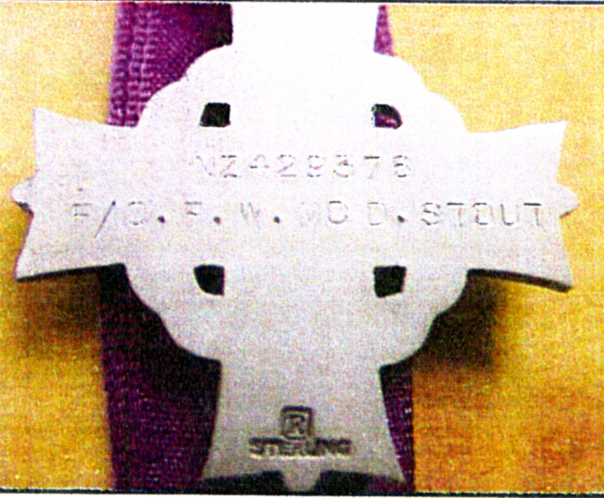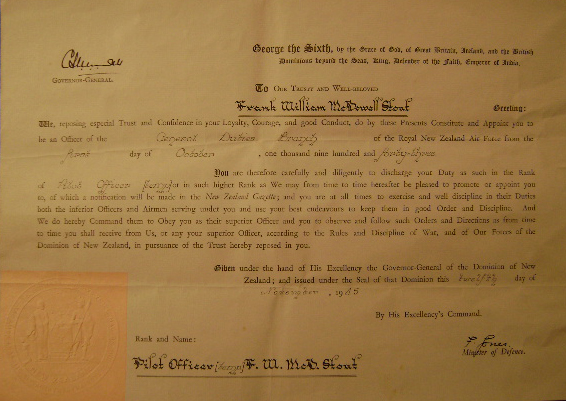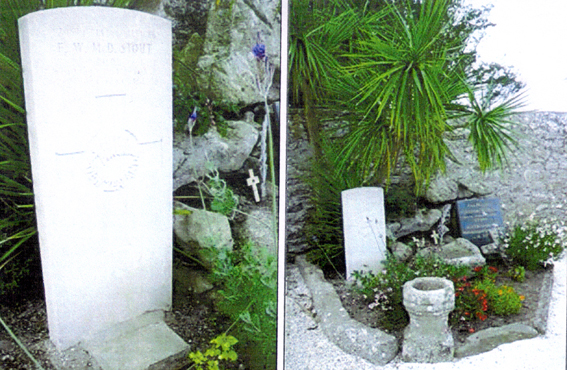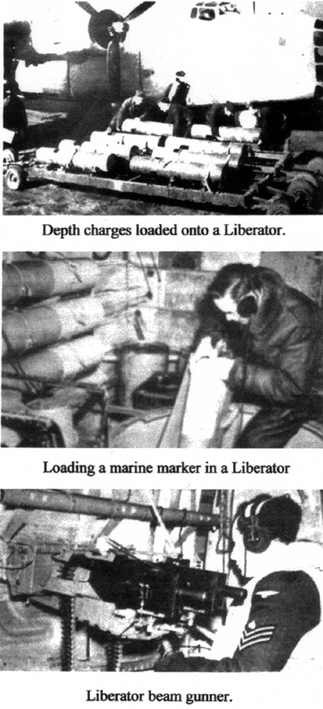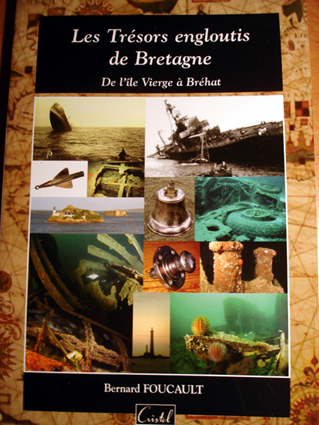 Flying
Officer (Co-pilot). STOUT, FRANK WILLIAM MCDOWELL Flying
Officer (Co-pilot). STOUT, FRANK WILLIAM MCDOWELL
547 RAF SQDN, Royal New Zeland Air Force Loss into the sea off the Ile de Batz on 18 June 1944 |
 |
|
He undertook his first training flight March 8 1943 (DH 89, Tiger Moth), and first solo March 17 after 9 hours dual flight. Assessed average. Embarked SS Lurline for Canada 17 May 1943. Attached Royal Canadian Air Force 31 May 1943. Arrived No. 7 Secondary Flying Training School, MacCleod, Canada 4 June. First flight Avro Anson, 15 June. By time of his last flight at MacCleod total flying time 230 hrs 5 minutes. No 31 G.R.S. Charlottetown, October-December 1943. Gained Pilot Badge (wings) 30 September1943 and appointed Sergeant 1 October 1943. Embarked for UK and attached to the Royal Air Force 20 January 1944. Stationed No. 3 AFU, South Gerney, Satellite "Souhrop". First flight in Airspeed Oxford 1 March 1944. Completed training on Airspeed Oxford 1 May 1944. Total flying time 292 hours 15 minutes. Posted to 547 Squadron RAF (Costal Command) based at St. Eval, Cornwall, flying Liberator bombers. Second Pilot to Flying Officer James William Herrniston, RCAF. Undertook three familiarisation flights, 19, 20 and 22 May, two day flights and one at night.
Commenced operations 13 June on Liberator "G", anti-submarine patrol in support of the invasion of France. Total duration 9 hrs 30 mins. Lost on an anti-submarine patrol as second pilot, 18 June 1944 in Liberator "E", Captain J/17585 Flying Officer, J. W. Hermiston and eight crew.
Extract from Errol Martyn, For Your Tomorrow : Sun 18 June 1944. Coastal Command. Anti-submarine patrol "I", Channel area. 547 Squadron, RAF (St Eval, Cornwall -19 group) Liberator GR. VI EV897/E, took off at 1150 captained by Flying Officer J W Hermiston, RCAF, and later seen circling over Brittany by the villagers of Roscoff, 3 km north of St Pol of Leon, with one or more engines on fire. Moments later the Liberator crashed in the sea near the Ile de Batz, a few kilometres north of the village. Picked up from the water and taken prisoner, the RAF flight engineer and RCAF wireless operator were the only survivors of the ten crew. Both were brought ashore at Roscoff, as was the body of the second pilot, the only one of the dead to by recovered at the scene. The body of another crew member was later recovered some distance away and is buried at Bayeux, while the six others, are commemorated on the Runnymede Memorial. The Germans sought to bury the New Zealander the following day but panicked and cancelled the interment when the entire population of Roscoff, accompanied by a further 2000 from surrounding villages, with over 100 of the children carrying bouquets, joined the procession in defiance of the occupying power. The body was secretly buried in the evening, an hour after the villagers were confined to curfew. Not to be denied the right to honour "their" airman (the only combatant of the war to be buried in the village), Roscoff's Catholic rector next day rang out the church bells. The procession reformed and he held a burial service of his own. 2nd Pilot : NZ429376 Flying Officer Frank William McDowell STOUT-Age 26. 311 hrs 2nd operation.
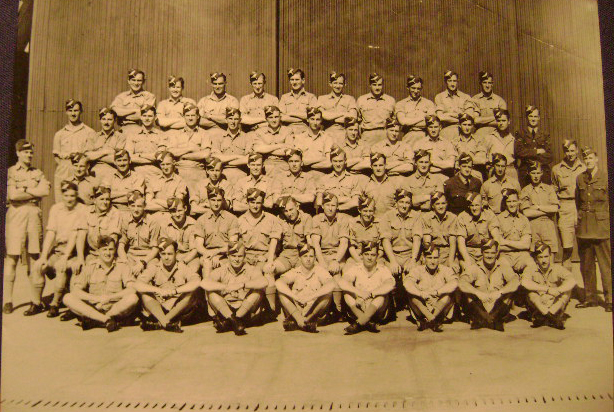
Frank Stout’s pilot training course, March 1943, at Harewood, Christchurch, New Zealand. He is front row 2nd from left.
Warrant of appointment as an officer in the RNZAF.
A LA MEMOIRE DE L'AVIATEUR NEO-ZELANDAIS STOUT FRANK WILLIAM MacDOWELL By John Stackhouse (copyright 2006)
The people of the small fishing village of Roscoff in Brittany, France, remain forever grateful for their New Zealander aviator, NZ429376 Flying Officer Frank William McDowell Stout, Royal New Zealand Air Force.
Frank Stout was born in Christchurch to parents William and Margaret Stout on 2 December 1917. After completing his primary education he attended Christchurch Boys' High School from 1932-34 At the time of entry into the Royal New Zealand Air Force he was a clerk with British Pavements Limited, Christchurch. He underwent initial flying training in the RNZAF at Harewood, Christchurch 1942-43 and then travelled to Canada to continue advanced training later in 1943, He arrived in England in early 1944 to complete his training and then was attached to the Royal Air Force.
Frank Stout had completed four flights with 547 Squadron (Coastal Command) as he clambered into the cavernous belly of the Liberator four-engined bomber, three of them training flights. With his aircraft captain Flying Officer Hemiston of the Canadian Air Force he was about to embark on his second anti-submarine operation. The bomber soon thundered down the runway at St Eval, Cornwall and ventured out over the Atlantic They turned to fly almost directly south across Cornwall and out into the English Channel. The Channel was abuzz with a myriad of craft supporting the recent landings in France.
The roar of aircraft and the sound of gunfire were not unusual in France in June 1944. The D-Day landings of 6th June in Normandy had been bloodily but successfully undertaken, the allied forces were gathering in France for the push to defeat the Germans, and the French looked forward to long-awaited liberation after over four years of occupation.
The villagers of Roscoff did stop, however, to look out into the bay on 18th June, 1944 to witness a drama unfolding. A large four-engined, circled, engines aflame, spiralling downward and obviously mortally wounded. Aboard the aircraft the lives of ten men, Englishmen, Canadians and a New Zealander, hung in the balance as the stricken plane plunged into the sea near the Ile de Batz. The Liberator bomber had been on anti-Submarine patrol to protect the shipping supporting recent landings when she had been damaged. The bomber, an American built plane operated by The Royal Air Force, was equipped to hunt out and destroy German U-Boats which were such a risk to Allied shipping.
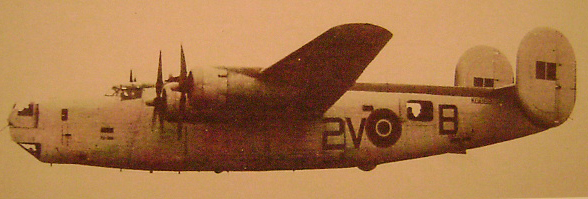
Liberator VI KG869/2V-B, 547 Squadron out on patrol during the winter of 1944-45
The Germans based at Roscoff immediately launched rescue craft to look for survivors from the bomber but they could find only two, the RAF Flight Engineer and the Royal Canadian Air Force Wireless Operator. They also retrieved the body of Second Pilot Frank Stout. The villagers stood silently watching as the airmen were brought ashore and Frank Stout's body was lifted onto the quay.
Word quickly spread around Roscoff and outlying villages that the New Zealand pilot was to be buried by the Germans in the local cemetery the following day. The Germans formed up the burial party on June 19th and prepared to move to the cemetery. The locals had been forbidden to attend the brief service as a gathering could lead to great trouble for the Germans.
However, Frank Stout had become Roscoff's airman, symbolising the sacrifice and struggle of many nations against the occupying Germans. The German burial party became agitated as villagers began to gather, not only from Roscoff but also from the surrounding villages. The crowd swelled as men, women and children poured through the narrow village streets. The throng soon numbered 4000 people, including 100 children carrying bouquets. Each one of the villagers knew that they risked being shot or imprisoned for their defiance. The Germans announced that the burial would not go ahead and that the crowd was to disperse. Instead the Germans buried Frank Stout hastily after the evening curfew. The local Catholic rector was aware of what the Germans had done and where Frank Stout's body lay. At great risk, again in defiance of the Germans, the rector rang out the church bells the next day as a signal to gather the people again. The procession of around 4000 was quickly formed and it filed to the local graveyard. The Germans did not stop the villagers but watched for any sign of trouble. The rector led a fitting burial service "for the New Zealand airman" under the watchful gaze of German authorities. A young New Zeeland airman from Christchurch had become a symbol of the struggle for freedom.
This poignant story does not end here. For many years an English woman, Marian Crouch, had spent her summer holidays in the beautiful little village of Roscoff, these holidays interrupted by the events of World War Two. She was captivated by the beauty of the little fishing village, its sheltered stone-quayed port and the friendliness and spirit or of its people. The hotel she stayed in was next to the graveyard and she often walked through it. She became intrigued by the gravestone of the New Zealand pilot, the only combatant of the war buried there, and the meticulous care that was taken over its upkeep. She also observed the reverence shown to the young man buried there by child and adult alike. The grave was topped by two headstones. A white-stoned marker was adorned with a cross into which was set a fern and the words "New Zealand". Above this were engraved the details of the pilot who lay there. This was the official headstone placed over the graves of all New Zealand servicemen. On the other side of the plot was a dark granite stone, erected by the local people which read : "A LA MEMOIRE DE L'AVIATEUR NEO-ZELANDAIS STOUT FRANK WILLIAM MacPOWALL. NE LE 2 DECEMBRE 1917. Mort en mer pour la cause des Allies LE 19 JUIN 1944." The grave was also adorned with another stone cross, a rockery, little flowering plants and a model of an aeroplane. Fittingly, a cabbage tree had been planted against the stone wall behind a little bit of New Zealand in a foreign field.
She recorded the details of Frank Stout and contacted the New Zealand authorities in London upon her return to Kent. They quickly traced the address of Frank Stout's mother, gave the details to Marion Crouch, and enclosing photographs of the grave she wrote to Mrs Stout in February 1951:
I know Roscoff - I go for my holidays there and I always visit the cemetery there at least once a day… I just love watching the care and attention that is paid to one grave there in particular. When I was 24 my husband was killed in the 1914-18 War in the last push - our small son was one year old the day he was killed - and I would love to feel that somewhere on foreign soil that his grave was being loved and cared for like the one in Roscoff. I have seen it now for so many times that I feel I must let his folk know. Even the children on their way to school just walk across the cemetery, stand a moment, take a sprig of green from the little water trough on the grave and bless it. If you knew Roscoff I am sure that you would love all these wee ones as well as the elders who have instilled such thoughts into young minds. I can't think of a nicer spot away from home or England for Flying Officer T. W. McD Stout to lie… nothing can be better cared for than this blessed spot.
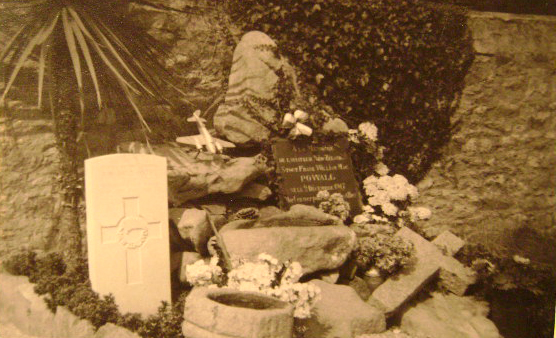 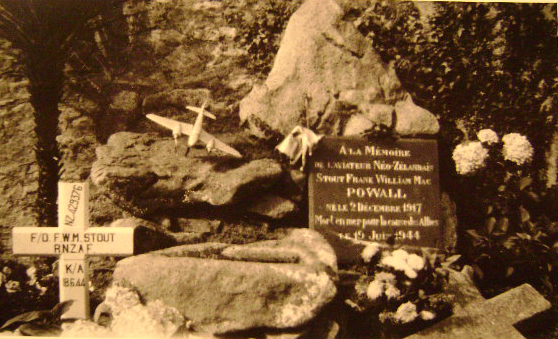
Photos of Frank Stout’s grave sent to Mrs Stout by Marion Crouch around 1950
Other information,
Frank William McDowell Stout was born in Christchurch on 2 December 1917. He attended Christchurch Boys' High School 1932-1934. He was employed as a clerk with British Pavements Ltd., Christchurch at time of enlistment. It appears he was called up for service in the army after having applied for the Air Force but before acceptance. He served in the 2nd Canterbury Regiment for 3 months. Initially he was engaged as administration staff officer at Omaka, entering RNZAF on 30 July 1942. Transferred to Woodbourne 13 Nov 1942. He applied for pilot training 22 July 1941.
Remustered as Pilot Under Training 4 January 1943, N° 3 Elementary Flying Training School, Harewood, Christchurch. He undertook his first training flight March 8 1943 (DH 89, Tiger Moth), and first solo March 17 after 9 hours dual flight. Assessed average. Embarked SS Lurline for Canada 17 May 1943. Attached Royal Canadian Air Force 31 May 1943. Arrived No. 7 Secondary Flying Training School, MacCleod, Canada 4 June. First flight Avro Anson, 15 June. By time of his last flight at MacCleod total flying time 230 hrs 5 minutes. No 31 G.R.S. Charlottetown, October-December 1943. Gained Pilot Badge (wings) 30 September1943 and appointed Sergeant 1 October 1943. Embarked for UK and attached to the Royal Air Force 20 January 1944. Stationed No. 3 AFU, South Gerney, Satellite "Souhrop". First flight in Airspeed Oxford 1 March 1944. Completed training on Airspeed Oxford 1 May 1944. Total flying time 292 hours 15 minutes. Posted to 547 Squadron RAF (Costal Command) based at St. Eval, Cornwall, flying Liberator bombers. Second Pilot to Flying Officer James William Herrniston, RCAF. Undertook three familiarisation flights, 19, 20 and 22 May, two day flights and one at night. Commenced operations 13 June on Liberator "G", anti-submarine patrol in support of the invasion of France. Total duration 9 hrs 30 mins. Lost on an anti-submarine patrol as second pilot, 18 June 1944 in Liberator "E", Captain J/17585 Flying Officer, J. W. Hermiston and eight crew. |
|
|
![]()
![]()
![]()
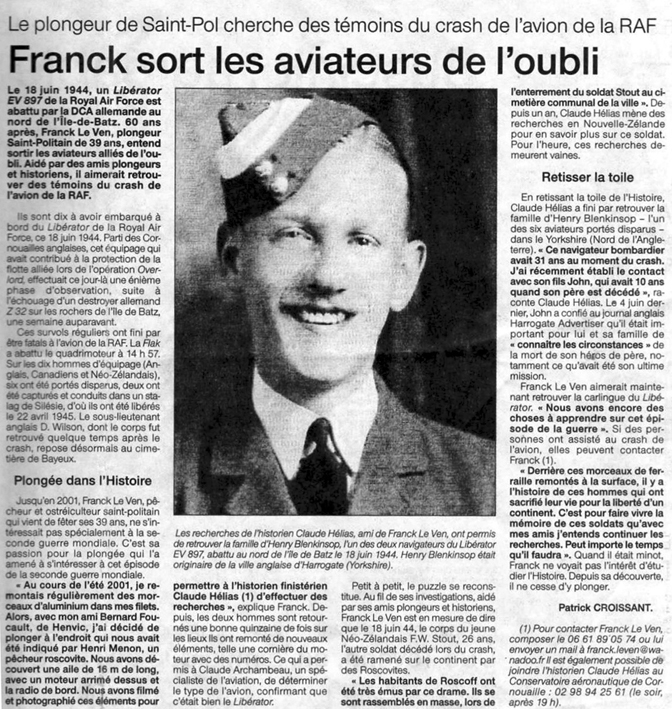 |
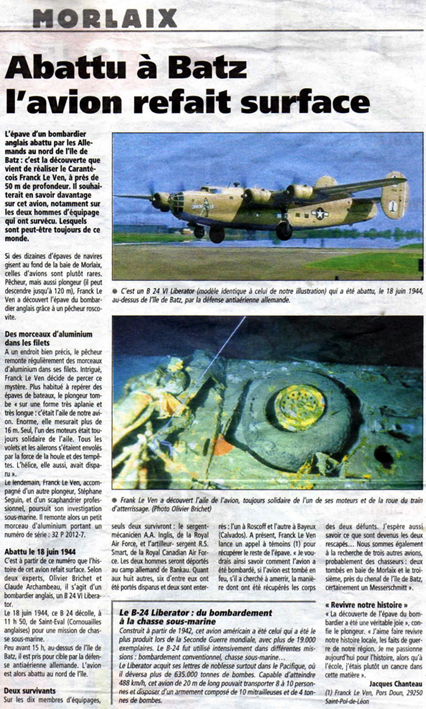 |
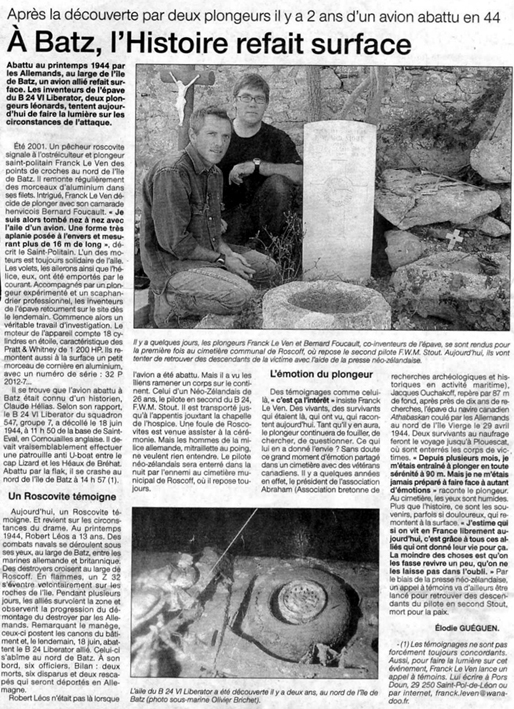 |
|
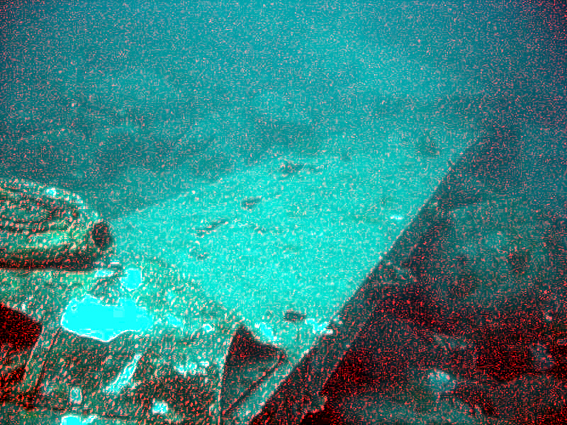 |
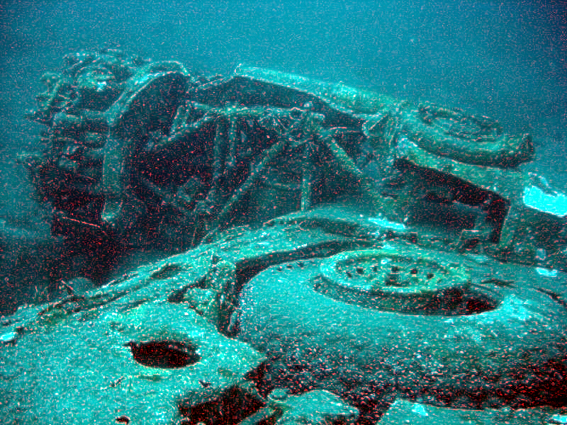 |
|
|
|
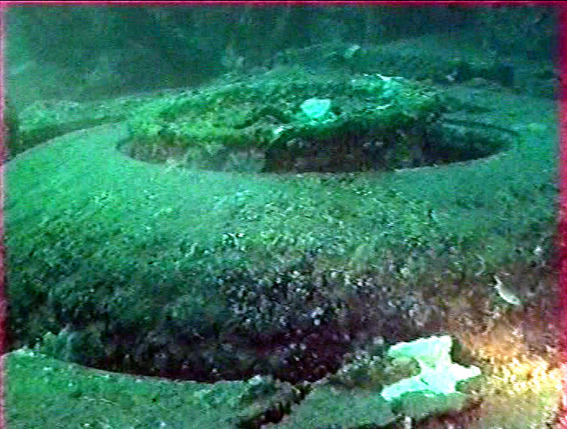 |
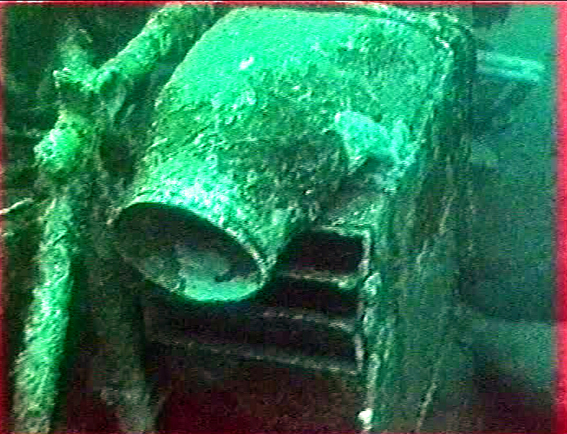 |
|
|
|
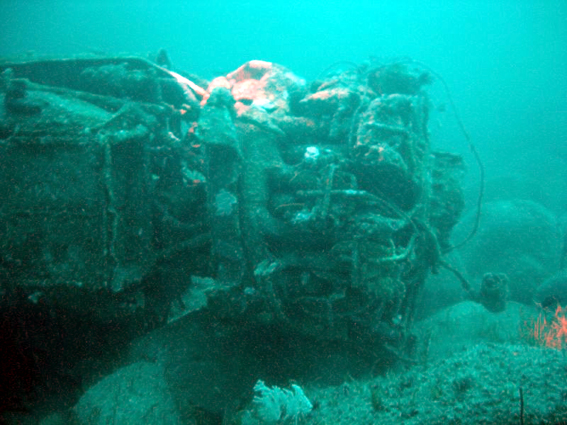 |
|
|
|
|
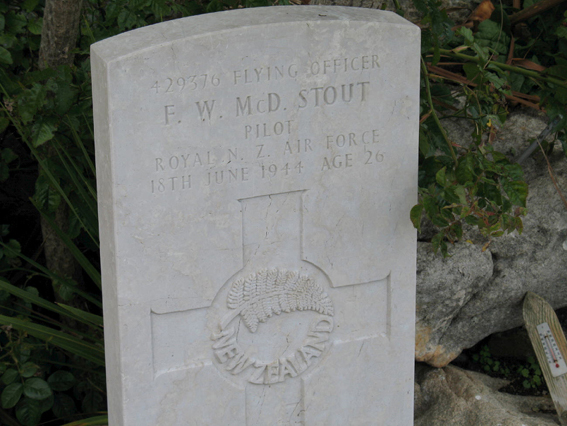
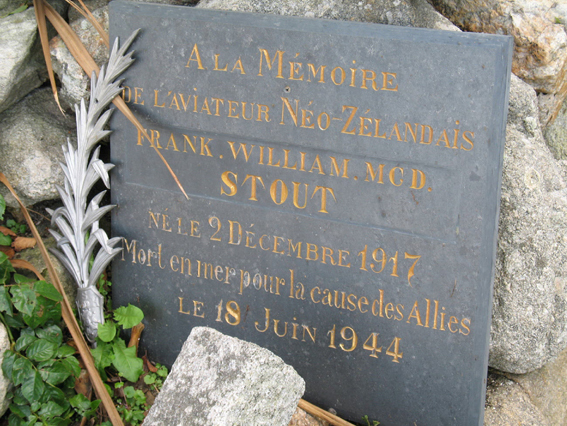
Story published in Les trésors engloutis de Bretagne, published CRISTEL - Author Bernard Foucault
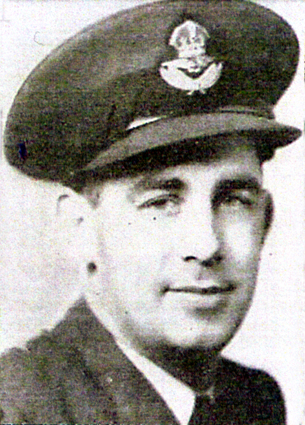 Remustered
as Pilot Under Training 4 January 1943, N° 3 Elementary
Flying Training School, Harewood, Christchurch.
Remustered
as Pilot Under Training 4 January 1943, N° 3 Elementary
Flying Training School, Harewood, Christchurch.
